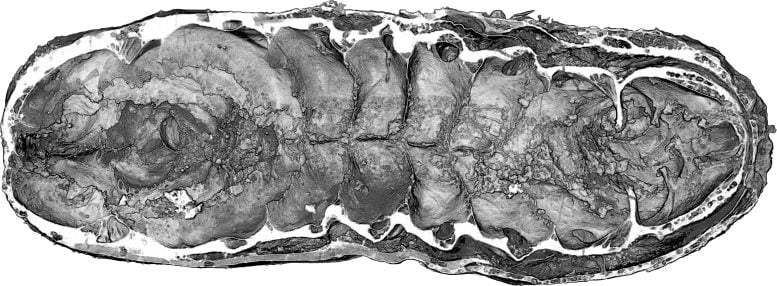
Durham University researchers discovered an extraordinarily detailed 520-million-year-old fossil, Youti yuanshi, revealing significant evolutionary insights into early arthropods’ complex anatomy and development.
A recent study conducted by researchers at Durham University has unveiled an exceptionally rare and detailed fossil named Youti yuanshi, providing a glimpse into one of the earliest ancestors of modern insects, spiders, crabs, and centipedes.
This fossil dates back over 520 million years to the Cambrian period, when the major animal groups we know today were first evolving. This fossil belongs to a group called the euarthropods, which includes modern insects, spiders, and crabs. What makes this fossil so special is that the tiny larva, no bigger than a poppy seed, has its internal organs preserved in exceptional quality.

Using advanced scanning techniques of synchrotron X-ray tomography at Diamond Light Source, the UK’s national synchrotron science facility, researchers generated 3D images of miniature brain regions, digestive glands, a primitive circulatory system and even traces of the nerves supplying the larva’s simple legs and eyes.
This fossil allows researchers to look under the skin of one of the first arthropod ancestors. The level of complexity anatomy shows these early arthropod-relatives were much more advanced than the researchers thought.
Insights from Lead Researchers
Lead researcher, Dr Martin Smith of Durham University said: “When I used to daydream about the one fossil I’d most like to discover, I’d always be thinking of an arthropod larva, because developmental data are just so central to understanding their evolution. But larvae are so tiny and fragile, the chances of finding one fossilized are practically zero – or so I thought! I already knew that this simple worm-like fossil was something special, but when I saw the amazing structures preserved under its skin, my jaw just dropped – how could these intricate features have avoided decay and still be here to see half a billion years later?”

Study co-author, Dr Katherine Dobson of the University of Strathclyde said: “It’s always interesting to see what’s inside a sample using 3D imaging, but in this incredible tiny larva, natural fossilization has achieved almost perfect preservation.”
Evolutionary Significance
Studying this ancient larva provides key clues about the evolutionary steps required for simple worm-like creatures to transform into the sophisticated arthropod body plan with specialized limbs, eyes, and brains. For example, the fossil reveals an ancestral ‘protocerebrum’ brain region that would later form the nub of the segmented and specialized arthropod head with its various appendages like antennae, mouthparts, and eyes.
This complex head allowed arthropods to take on a wide range of lifestyles and allowed the researchers to become the dominant organisms in the Cambrian oceans. Details like these also help trace how modern arthropods gained their incredible anatomical complexity and diversity and came to be the most abundant group of animals today.
The researchers point out that the fossil fills an important gap in our understanding of how the arthropod body plan originated and became so successful during the Cambrian Explosion of life.
This remarkable specimen is housed at Yunnan University in China, where it was originally discovered.
Reference: “Organ systems of a Cambrian euarthropod larva” by Martin R. Smith, Emma J. Long, Alavya Dhungana, Katherine J. Dobson, Jie Yang and Xiguang Zhang, 31 July 2024, Nature.
DOI: 10.1038/s41586-024-07756-8
1 Comment
“… allowed the researchers to become the dominant organisms in the Cambrian oceans.” Amazing that they are that old and still publishing!